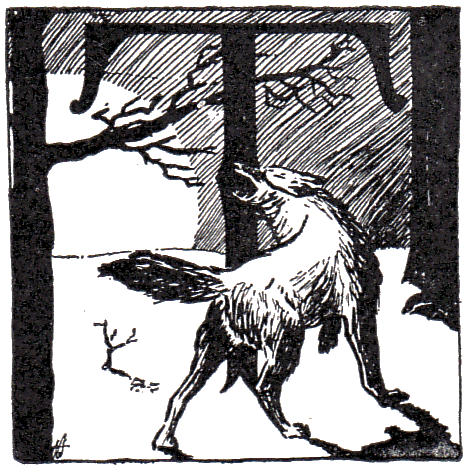|
|
|
|
|
|
|
|
|
|
|
|
|
|
|
|
|
|
|
|
|
|
|
|
|
The Wolf
|
|
|
|
|
|
|
|
|
|
|
|
|
|
|
|
|

|
|
The Wolf
 HE study of the wolf should precede the lessons
on the fox and the dog. After becoming
familiar with the habits of wolves, the pupils
will be much better able to understand the
nature of the dog and its life as a wild animal.
In most localities, the study of the wolf must,
of course, be a matter of reading, unless the
pupils have an opportunity to study the
animal in traveling menageries
or in zoological gardens. However, in all
the government preserves, the timber wolf has
multiplied to such an extent, that it may
become a factor in the lives of many people in the United States. This
wolf ranged in packs over New York State a hundred years ago, but
was finally practically exterminated in most of the eastern forests, except
in remote and mountainous localities. A glance at Bulletin 72 by
Vernon Bailey, published by the U. S. Department of Agriculture,
Forest Service, is a revelation of the success of the timber wolf, in
coming back to his own, as soon as the forest preserves furnished
plenty of game, and forbade hunters. Timber wolves are returning of
late years to Western Maine and Northern New Hampshire; Northern
Michigan and Wisconsin have them in greater numbers; some have also
been killed in the Appalachian
Mountains of Tennessee, Virginia and West
Virginia, but their stronghold is in the great Rocky Mountain Region and
the Northwestern Sierras, from which they have never been driven.
HE study of the wolf should precede the lessons
on the fox and the dog. After becoming
familiar with the habits of wolves, the pupils
will be much better able to understand the
nature of the dog and its life as a wild animal.
In most localities, the study of the wolf must,
of course, be a matter of reading, unless the
pupils have an opportunity to study the
animal in traveling menageries
or in zoological gardens. However, in all
the government preserves, the timber wolf has
multiplied to such an extent, that it may
become a factor in the lives of many people in the United States. This
wolf ranged in packs over New York State a hundred years ago, but
was finally practically exterminated in most of the eastern forests, except
in remote and mountainous localities. A glance at Bulletin 72 by
Vernon Bailey, published by the U. S. Department of Agriculture,
Forest Service, is a revelation of the success of the timber wolf, in
coming back to his own, as soon as the forest preserves furnished
plenty of game, and forbade hunters. Timber wolves are returning of
late years to Western Maine and Northern New Hampshire; Northern
Michigan and Wisconsin have them in greater numbers; some have also
been killed in the Appalachian
Mountains of Tennessee, Virginia and West
Virginia, but their stronghold is in the great Rocky Mountain Region and
the Northwestern Sierras, from which they have never been driven.
![[Illustration]](http://www.gatewaytotheclassics.com/bronze/books/comstock/mammals/comstock_mammals_zpage255.gif)
Gray Wolf
|
It might be well to begin this lesson on the wolf with a talk about the
gray wolves which
our ancestors had to
contend with, and also with stories of the coyote or prairie wolf which has
learned to adapt itself to civilization and flourishes in the
regions west of the
Rocky Mountains,
despite men and
dogs. Literature is
rich in wolf stories.
Although Kipling's
famous Mowgli
Stories belong to
the realm of fiction,
yet they contain
interesting accounts
of the habits of the
wolves of India, and
are based upon the
hunter's and tracker's
knowledge of these animals. We have many thrillingly interesting
stories in our own literature which deal with our native wolves. The
following are among the best:
"Lobo" in Wild Animals I Have Known; "Tito" in Lives of the
Hunted; "Bad Lands Billy and the Winnipeg Wolf" in Animal Heroes,
all by Thompson Seton; "The Passing of Black Whelps" in Watchers of
the Trail by Roberts; Northern Trails by Long; "Pico, Coyote" by Coolidge
in True Tales of Birds and Beasts.
For more serious accounts of the wolves see American Animals,
p. 277; The "Hound of the Plains" in Wild Neighbors, and page 188 in
The Life of Animals, both by Ingersoll. "The Coyote" by Bret Harte and
"The Law of the Pack" in The Second Jungle Book bring the wolf
into poetry.
From some or all of these stories, the pupils should get information about
the habits of the wolves. This information should be incorporated in an
essay or an oral exercise and should cover the following
points: Where do the wolves live? On what do they feed? How
do they get their prey? Do they hunt alone or in packs? How do they
call to each other? Description of the den where the young are reared.
The wolf's cleverness in eluding hunters and traps.
![[Illustration]](http://www.gatewaytotheclassics.com/bronze/books/comstock/mammals/comstock_mammals_zpage256.gif)
"Katrina Wolfchen," the Pet Coyote
of Professor Fred S. Charles
|
|











